
Our 'day off' in Coyhaique followed the usual format of being busier than a cycling day, shopping, cleaning clothes, internetting, and fixing the bikes. For the last week both of us had experienced problems stopping on the steeper descents and realised that we had absolutely no brake pads left, so these were top of the list. The bike shop in town was excellent so I was finally able to replace my broken front racks. Catherine has politeley offered to continue using my botch-job repair rather than buy new rear racks, although I suspect that it's because she plans to spend the money on pisco sours.
We said goodbye to our Chilean tourer friends that we had being seeing on and off since La Junta, as they headed back up north from this point, but we bumped back into James again, the Canadian from the Futaleufu border crossing, so it was nice to catch up about the last week of travelling.
We decided to change our route slightly, so the next morning we headed towards Puerto Ibañez on the northern shore of Lago General Carrera, where we would catch the ferry to Chile Chico and cycle the southern shore to rejoin the Carretera Austral at Cruce El Maiten. The idea being that we would save ourselves a few km of cycling, and would break the journey a bit with a lake crossing. The journey out of Coyhaique is the same either way, at least for the first 100km, so we enjoyed a rare but great day of paved roads and beautiful high, lush dairy pasture in wide forested valleys. With the paved surface came a welcome return to the long distances, and we covered 120km, but the route included a 2km vertical climb, so nothing comes for free. James caught up with us during the day so we cycled together for a while and after the last climb we were treated to one of the best views of the trip: Cerro Castillo. As the road twists sharply downhill, you enter a wide grassy basin surrounded by huge snow-capped mountains, crested with granite crags and spires that resemble the battlements of a castle (hence the name).
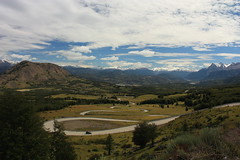
The road was a cyclist's dream with wide swooping turns and a serious camber, making it feel like a downhill velodrome (we clocked another 70km/hr today). The feeling of leaning into the curves on this road was as close an experience as you could get to skiing or boarding on a bike I imagine.

The road was a cyclist's dream with wide swooping turns and a serious camber, making it feel like a downhill velodrome (we clocked another 70km/hr today). The feeling of leaning into the curves on this road was as close an experience as you could get to skiing or boarding on a bike I imagine.
This elation lasted until we arrived at Puerto Ibañez, one of those places that you never wish to return to. There are some boring reasons, but the life has gone from this place ... and it's inhabitants. I'm not feeling charitable towards them because their tourist office gave out the wrong vital info about the boats, and the woman in the actual ferry ticket office lied and told me that there were no spaces available for at least a week. I assume that she was at a crucial point in her favourite soap opera and didn't want to be kept any longer than necessary. Thanks again to Joan who arrived later that night (after swapping his doomed trailer for panniers), as he had reserved 3 tickets from Coyhaique whilst he was waiting for the mechanic. The only reason to be in Ibañez is to catch the ferry; thru-traffic seems to be their life-blood, and the idiots managed to get the departure time, availability of tickets, and the method of acquiring them wrong. Argentina was charmingly haphazard at times but Chile seems to be frequently and frustratingly inept.
As the ferry left at 6pm the following day and not 10am as we had been told, we had a day to kill here, so we made the best of it with a lie-in at the camp site, a cooked breakfast and an asado for lunch. We were amazingly lucky with the weather so I was also able to top up my sunburn under a blazing sunny blue sky. The meat was great; ribs and a whole beef roasting joint cooked for two hours over a wood fire. Bananas and chocolate for dessert.
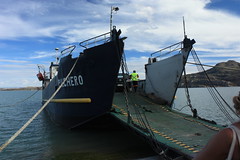

The boat trip was definately worth the wait. Lago General Carrera is the second largest body of fresh water in South America and is cut north to south by the international border between Chile and Argentina. It widens to the west, where it almost looks like an ocean, whilst to the west it narrows between huge snowy ranges fringed with clouds. The day we crossed, the water was like a mirror, and it created amazing reflections of the sunset. The best part however was the fact that the captain had dressed his son up as a mini-captain, complete with navy blazer and silver stars. The power had obviously gone to his head and at one point he held Joan's nose until he admitted to smuggling beers on board. The precocious little tyke even spoke solely in nautical terminology, and when we reached land he asked if we could disembark to 'tierra firma'. He was 8. We half-heartedly tried hitching along the southern shore but no traffic was passing so we stayed in a prison-like, but friendly, residencial.
The rain poured down the next day and didn't show any signs of getting better. We decided to stick with the motorized transport option, so we asked around for a bus or taxi that would take us to Puerto Tranquilo, the launch point to see the famous marble caves on the western shore of the lake. We found Fernando and he drove us along a spectacular but challenging stretch of road that we almost wish we had cycled. Almost.
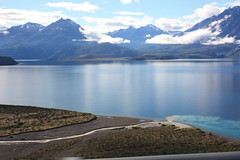
We woke early the next morning to visit the marble caves but the drizzle hadn't stopped. We sat in wet plastic ponchos on wet plastic seats in a wet plastic boat. The marble caves were amazing though and the weather eventually cleared a bit to allow the photos to not look too depressing. The water has carved huge caverns out of the marble and they are patterned with the natural stripes and colours of the rock. All of this is reflected in the milky glacial water of the lake, illminated by the white marble floor bouncing the light back upwards again.
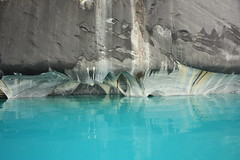

We woke early the next morning to visit the marble caves but the drizzle hadn't stopped. We sat in wet plastic ponchos on wet plastic seats in a wet plastic boat. The marble caves were amazing though and the weather eventually cleared a bit to allow the photos to not look too depressing. The water has carved huge caverns out of the marble and they are patterned with the natural stripes and colours of the rock. All of this is reflected in the milky glacial water of the lake, illminated by the white marble floor bouncing the light back upwards again.

After the trip we set off cycling south at around noon after two and a half days off the bikes. The route around the lake was as challenging and spectacular as the section that we had decided to miss out so maybe no time was gained after all. The day brightened and we had spectacular views of the lake and it's mirror reflections of the surrounding mountains.
We camped at a farmhouse next to the amazingly green Rio Baker. The owner let us sleep in a barn with a fire pit, so we were toasty warm and out of the drizzle that came with the evening.
The next morning we cycled past expensive fishing lodges on a bumpy rollercoaster road following the rio Baker south. Catherine briefly terrified me by telling me that she saw a ghost on the road; a cyclist wearing all black, approaching me whilst I was turned to talk to her. Needless to say it was probably a horse, but as I wear all black most days I spent the rest of the day convinced that this was a premonition of my falling off a cliff into the river. Having another painful fall from my bike shortly after, on a fast section of downhill, was not helping me feel any more secure. Both me and Joan fell hard today and we all seem to have our own particular style in falling. Catherine's specialty is usually falling on gravel, landing face down with the bike mostly on top of her; Joan has nearly mastered the art of leaping frog-like from his bike when he senses a fall is iminent (he only comes unstuck when a foot gets tangled in his bags); and I have been practising the 'bronze-gymnastics-badge' forward roll over the handlebars.
We eventually entered Cochrane, the last town of any real size (bigger than 500 inhabitants) on the southern Carretera Austral. It has a real 'last outpost' feel but was nothing compared to the towns to come. We had lunch and passed through quickly as we wanted to break the back of the 130km to Caleta Tortel, the next town. We stopped in the woods for the night, shooing the cows from our site, and lit a fire. This was another idyllic camp on a mountainside next to a fast-flowing stream, and we even cooked sausages on the fire, skewered onto tent pegs driven through a log. The night was clear and the stars were excellent that night. I still had nightmares about Catherine's vision though.
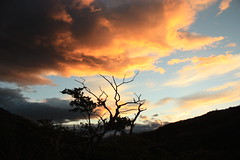
We still had 100km to reach Caleta Tortel the next day, something we hadn't yet done on ripio road so we left camp early. The road was only to get more lonely and isolated but this was our first real taste of true Patagonia; absolutely nothing but a dirt track winding through wilderness. We cycled though wide glaciated valleys, through thick forests, and along narrow ledges hugging the steep cliffs. Very little traffic passes, just a handful of trucks in 10 hours on the road, and there are no sounds beyond the wind. Unfortunately the lovely silence was eventually broken by a contender for 'idiot of the trip', an Aussie cycle tourer heading north with two Swiss cyclists. I'll say no more than he talked almost continuously about himself and even described himself as 'an animal'. The Swiss couple looked at the ground throughout with a resigned look that suggested they had become stuck cycling in the same direction, and at the same speed, as an idiot.


We still had 100km to reach Caleta Tortel the next day, something we hadn't yet done on ripio road so we left camp early. The road was only to get more lonely and isolated but this was our first real taste of true Patagonia; absolutely nothing but a dirt track winding through wilderness. We cycled though wide glaciated valleys, through thick forests, and along narrow ledges hugging the steep cliffs. Very little traffic passes, just a handful of trucks in 10 hours on the road, and there are no sounds beyond the wind. Unfortunately the lovely silence was eventually broken by a contender for 'idiot of the trip', an Aussie cycle tourer heading north with two Swiss cyclists. I'll say no more than he talked almost continuously about himself and even described himself as 'an animal'. The Swiss couple looked at the ground throughout with a resigned look that suggested they had become stuck cycling in the same direction, and at the same speed, as an idiot.

We eventually arrived at Tortel, a fascinating town hugging a steep cliff and circling a small bay in one of the many fjords along the Pacific coast. The entire town is built on stilts and is linked with a maze of raised boardwalks and steep staircases. The town was only accessible by boat until about 15 years ago and they still contact eachother by radio. The staircases wind down the hillside between the wooden houses and the trees, curving around rocks and other obstacles, ending in a series of jettys and piers at the waterside. The night we were there, they were celebrating their annual festival with a singing contest in the town hall. We were lucky enough to arrive just as they announced the winner of the children's category, and were treated to a screeching but totally motionless fat child belting out a Chilean cowboy song. He was followed by the town lothario; a well-seasoned performer in a wide brimmed hat, shiny leather boots and an even shinier face. He had an eye for the ladies, although he evidently had an eye for the empanadas too, so he sweated enough to make Catherine worry that she might be called upon as a nurse. We went to bed after midnight but the party was obviously going to go on all night.
Joan had followed behind us on the approach to Tortel and had met a German couple called Holger and Karin along the way. The five of us shared a lovely wooden cabaña and decided over a few beers that we would charter a fishing boat the next day to take us directly to Rio Bravo, the shore of the final stretch of the Carretera Austral. The tourist information office told us that this was only possible for about 150,000 Chilean pesos (about 220quid), but whilst this was expnsive, it was affordable between the five of us and it would save us haf a day on the road. It would also break the journey with a scenic 3-hour chug around the fjords. We asked around the docks that night and were quoted the same price by a few captains stood by their boats. The morning after the party however, we walked the length of the docks trying to find the same captains but they were all drunk or absent, still dancing in the town hall higher up the hill. We eventually asked a couple of drunk sailors what we should do and they told us that there was a free boat, subsidised by the governement to keep the community connected to their neighbours, leaving in half an hour. They even directed us to the captain's house and he was surprisingly sober.
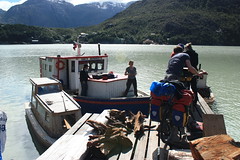
The lesson here is that a drunken sailor is still more reliable than a Chilean tourist information office. Our luck was incredible actually because when we asked the captain during the voyage why he ran a free ferry whilst the others were charging so much, he said that the service runs just twice a month and he does it do link the remoter families, provided that the government pay his fuel costs. Both he and his mate were wonderful and genuinely generous guys, and they wouldn't even accept a tip at the end of the journey.
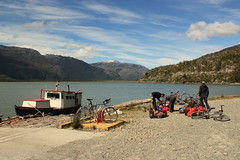

The lesson here is that a drunken sailor is still more reliable than a Chilean tourist information office. Our luck was incredible actually because when we asked the captain during the voyage why he ran a free ferry whilst the others were charging so much, he said that the service runs just twice a month and he does it do link the remoter families, provided that the government pay his fuel costs. Both he and his mate were wonderful and genuinely generous guys, and they wouldn't even accept a tip at the end of the journey.

They dropped us off at a lonely jetty that marks the final 100km of track to Villa O'Higgins, the furthest outpost on the Carretera Austral. We needed to cover about 30km before nightfall to make the final day achieveable, and the five of us eventually set up camp in a swampy nest of mosquitoes. Night fell, the drizzle started, and we were carpeted in mosquitoes that have no qualms about biting your face. We still managed to create a respectable 3 course meal (with wine), but we ate it all through tightly closed hoods,and with every millimeter of skin covered. Nobody escaped this unscathed and we are still itching now. Joan came off worst however and Holger commented dryly that his legs looked like a popular German cake known as 'cauilflower cake'.
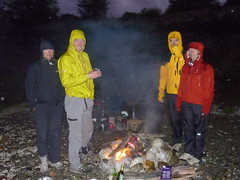

The mozzies were back in the morning so breakfast was quick, and we hit the road early for the final 70km. After a trio of steep climbs right at the start of the day, the road levelled out but the surface was still pretty bad; like cycling along a cobbled street where every second stone is missing. The feeling of remoteness was absolute now, as we cycled along empty tracks past dead forests submerged in inky black lagoons. The sky was cold and grey, the hillsides were barren apart from the waterfalls crashing beside the path, and the snowline had dropped to just 200m.
In the afternoon however, the sky brightened and the scenery became greener. We were eventually cycling alongside sandy beaches looking out over deep blue lakes dotted with black-necked swans. Eventually we rode through long stretches of dense, mossy beech forests until we reached Villa O'Higgins, the isolated outpost at the end of the Carretera Austral.
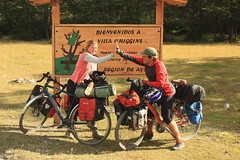
From here you leave the road and have to attempt a cross-country border crossing into Argentina via a series of lake crossings and mountain passes linked only with horse tracks. We will have to hire horses to carry our bags and then wheel and carry our bikes for 6 hours through streams, rivers and forests until we reach a dirt track on the Argentinian side. Needless to say, I didn't explain this in detail to Catherine before we started this section.

From here you leave the road and have to attempt a cross-country border crossing into Argentina via a series of lake crossings and mountain passes linked only with horse tracks. We will have to hire horses to carry our bags and then wheel and carry our bikes for 6 hours through streams, rivers and forests until we reach a dirt track on the Argentinian side. Needless to say, I didn't explain this in detail to Catherine before we started this section.
We were going to have a rest day and get the first ferry on the Wednesday, but we found out that the National Geographic had chareterd the boat for a short expedition to a remote glacier, so we couldn't leave for another day. We actually asked the guys if we could tag along on their trip but there wasn't the space. Or we smelled too bad. Two days of rest and relaxation it is then. Shame.
Day 41: Coyhaique to Puerto Ibañez - 117km
Day 42: Puerto Tranquilo to Puerto Bertrand - 71km
Day 43: Puerto Bertrand to The Forest - 70km
Day 44: The Forest to Caleta Tortel - 100km
Day 45: Caleta Tortel to Mosquito Hell - 30km
Day 46: Mosquito Hell to Villa O'Higgins - 70km
Looking at the map you appear to be miles from the quake zone, but I just thought I'd check in anyway... Still in good shape I hope?
ReplyDeleteThanks for caring Dan, you big bear, you. We are indeed miles from the quake zone and, tsunamis permitting, we should be fine. We actually re-entered Chile this morning (the blog is about a week behind) but the coast here is protected by thousands of islands anyway. An penguins.
ReplyDeleteThis comment has been removed by the author.
ReplyDeleteglad you missed the quake. great photos and blogs - keep it up. sounds like you need to know how to curse better in spanish - we will make sure you are better prepared next time!
ReplyDeleteenjoy the pisco sours mal & jean
Thanks guys. You'd have been proud of us last night ... it was a big night on the pisco to celebrate finishing the Paine trekking circuit. After walking 145km we needed a splitting pisco headache to take our minds off the pain in our feet! ;)
ReplyDeleteWe're still working on the cursing.
Come on, where's the next bit. I've been waiting for ages
ReplyDelete